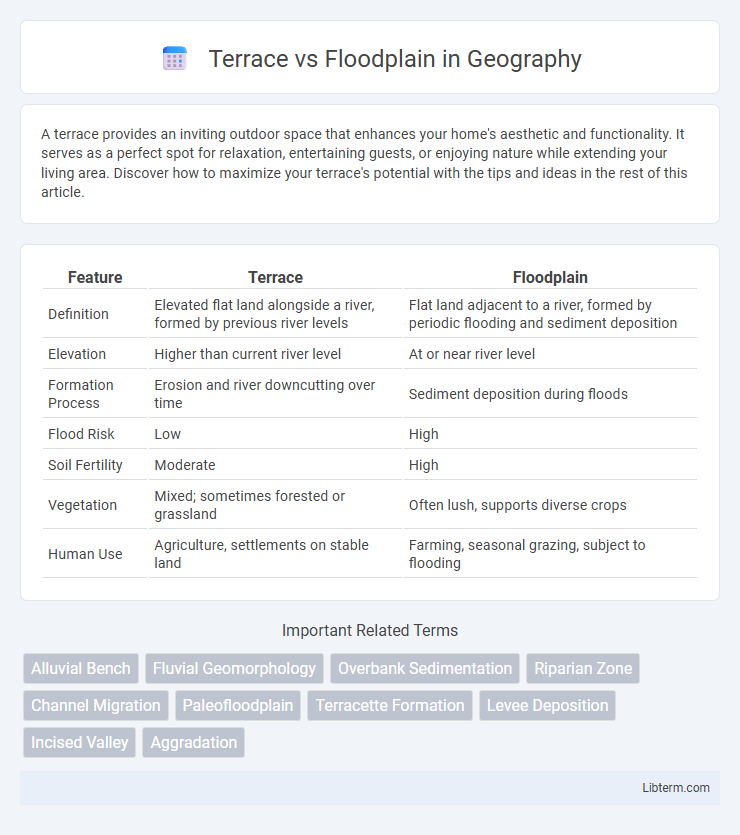A terrace provides an inviting outdoor space that enhances your home's aesthetic and functionality. It serves as a perfect spot for relaxation, entertaining guests, or enjoying nature while extending your living area. Discover how to maximize your terrace's potential with the tips and ideas in the rest of this article.
Table of Comparison
| Feature | Terrace | Floodplain |
|---|---|---|
| Definition | Elevated flat land alongside a river, formed by previous river levels | Flat land adjacent to a river, formed by periodic flooding and sediment deposition |
| Elevation | Higher than current river level | At or near river level |
| Formation Process | Erosion and river downcutting over time | Sediment deposition during floods |
| Flood Risk | Low | High |
| Soil Fertility | Moderate | High |
| Vegetation | Mixed; sometimes forested or grassland | Often lush, supports diverse crops |
| Human Use | Agriculture, settlements on stable land | Farming, seasonal grazing, subject to flooding |
Introduction: Terrace vs Floodplain
Terraces are elevated, flat areas alongside valleys formed by river erosion and sediment deposition over time, representing former floodplain levels now abandoned by active streams. Floodplains are low-lying areas adjacent to rivers that experience periodic flooding, serving as dynamic environments for sediment accumulation and nutrient-rich soil development. Understanding the distinction between terraces and floodplains is crucial for geomorphology, agriculture, and flood risk management.
Defining Terraces and Floodplains
Terraces are elevated, flat or gently sloping landforms that represent remnants of former floodplain surfaces formed by river incision and sediment deposition over geological time. Floodplains are low-lying, flat areas adjacent to rivers that experience regular flooding, characterized by fine sediment accumulation and nutrient-rich soils. Both terraces and floodplains reflect different stages of river dynamics and sedimentary processes, influencing soil fertility and land use potential.
Formation Processes of Terraces
Terraces form through fluvial processes involving the uplift of land or a decrease in river discharge, causing erosion of previous floodplains and leaving elevated flat surfaces above the current river level. These step-like landforms develop as a river incises its channel into bedrock or sediment, creating a distinct bench parallel to the river. Floodplains, in contrast, are low-lying areas formed primarily by the deposition of alluvium during overbank flooding events.
Formation Processes of Floodplains
Floodplains form primarily through the processes of sediment deposition during periodic river overflows, where fine particles settle as floodwaters recede, creating rich, fertile soils. These alluvial plains develop adjacent to river channels, shaped by the lateral migration of rivers and gradual accumulation of sediments in low-lying areas. In contrast, terraces represent former floodplain surfaces elevated by river incision or changes in base level, marking previous stages of river activity.
Key Differences in Geomorphology
Terraces are elevated, step-like landforms formed by the downcutting and lateral erosion of rivers, representing former floodplain levels uplifted or left stranded by changing river dynamics. Floodplains are flat, wide areas adjacent to rivers, created by sediment deposition during periodic flooding, characterized by fine alluvial soils and active sedimentation processes. The primary geomorphological difference lies in terraces being remnants of past river beds elevated above current channels, while floodplains are active, low-lying surfaces shaped continuously by water flow and sediment deposition.
Soil Characteristics and Fertility
Terrace soils typically exhibit well-drained, stratified layers with moderate to high fertility due to reduced erosion and nutrient retention over time. Floodplain soils are often rich in organic matter and nutrients, benefiting from regular sediment deposits during flooding that enhance fertility and soil moisture. The contrast in soil texture and nutrient content between terraces and floodplains influences crop selection and agricultural productivity.
Agricultural Suitability and Uses
Terraces offer enhanced agricultural suitability by providing well-drained, erosion-controlled land, ideal for cultivating high-value crops such as fruits, vegetables, and grains. Floodplains, characterized by nutrient-rich alluvial soils, support extensive agriculture but pose risks due to periodic flooding, making them suitable for flood-tolerant crops like rice and certain cereals. Effective land management practices optimize terrace farming for sustainable crop yield, while floodplain agriculture benefits from natural soil fertility and water availability.
Ecological and Environmental Impacts
Terraces act as elevated landforms that reduce soil erosion and provide stable habitats for diverse plant and animal species, enhancing biodiversity compared to floodplains. Floodplains absorb floodwaters, replenish groundwater, and support nutrient-rich soils, fostering high productivity but are vulnerable to habitat disruption during extreme flooding events. The contrast in water dynamics between terraces and floodplains influences their capacity to support various ecosystems and affects regional hydrology and sediment transport.
Flood Risks and Water Management
Floodplains, characterized by their flat terrain adjacent to rivers, are highly susceptible to flooding due to their low elevation and proximity to water bodies, requiring comprehensive flood risk management strategies such as levees, retention basins, and controlled flooding zones. Terraces, being elevated step-like landforms often formed by river incision, naturally reduce flood risk by positioning settlements and agriculture above typical flood levels, but still require effective water management to handle runoff and prevent erosion. Effective water management on floodplains integrates natural flood mitigation methods like wetland restoration with engineered solutions, while terraces benefit from contour farming and drainage systems to optimize water retention and minimize erosion.
Conclusion: Choosing Between Terrace and Floodplain
Choosing between terrace and floodplain environments depends on specific land use goals and risk tolerance. Terraces offer elevated, stable ground with reduced flood risk, making them ideal for building infrastructure and permanent agriculture. Floodplains provide fertile soil and water availability but require careful flood management to mitigate potential damage.
Terrace Infographic

 libterm.com
libterm.com